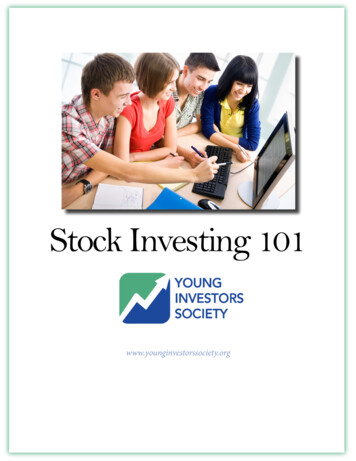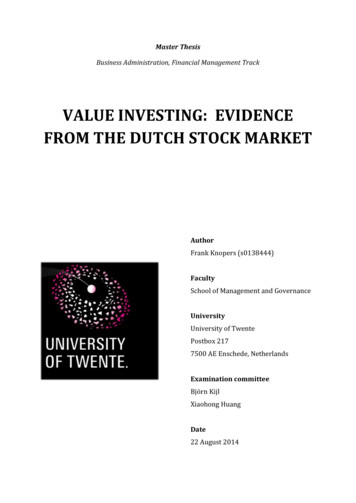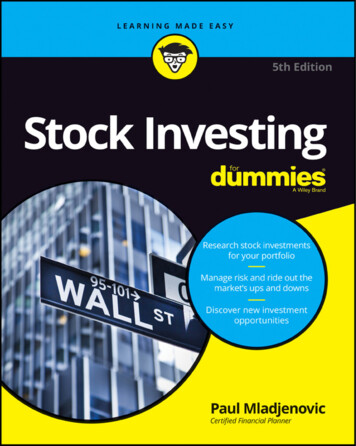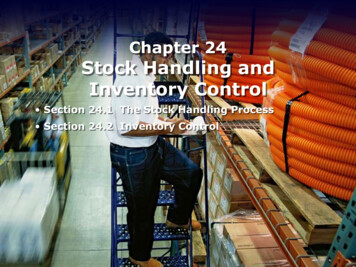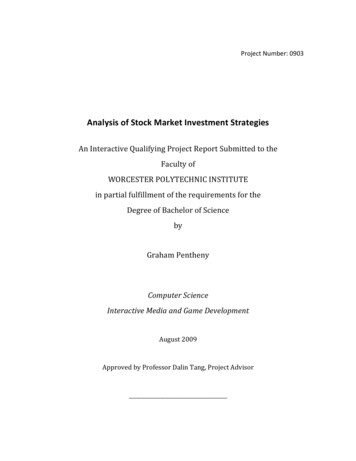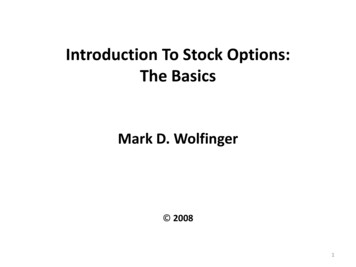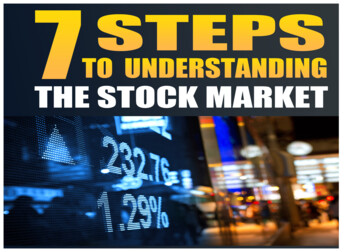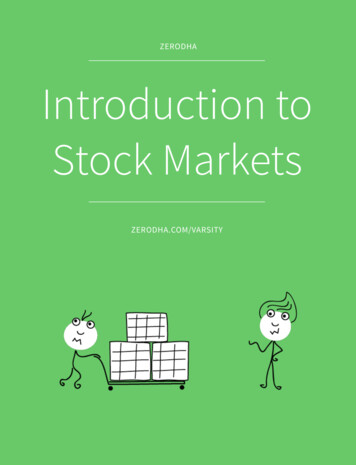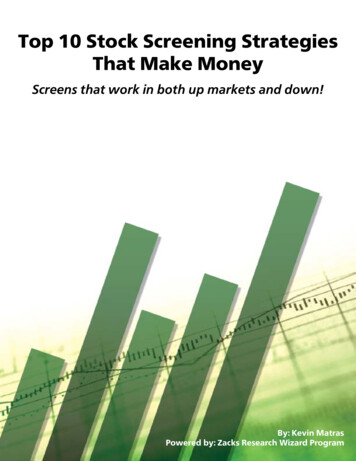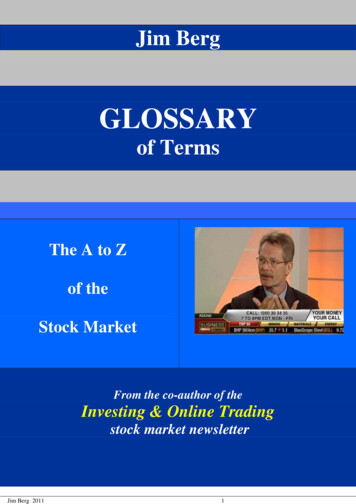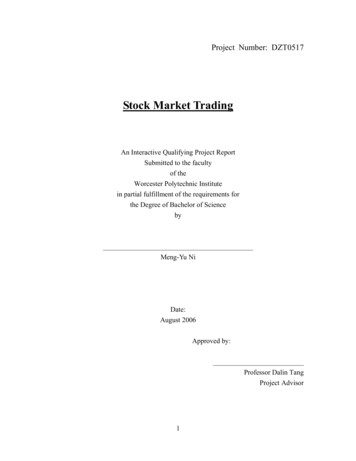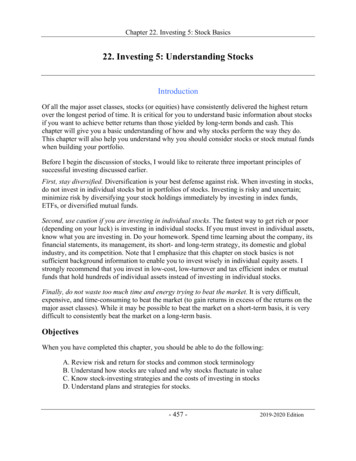
Transcription
Chapter 22. Investing 5: Stock Basics22. Investing 5: Understanding StocksIntroductionOf all the major asset classes, stocks (or equities) have consistently delivered the highest returnover the longest period of time. It is critical for you to understand basic information about stocksif you want to achieve better returns than those yielded by long-term bonds and cash. Thischapter will give you a basic understanding of how and why stocks perform the way they do.This chapter will also help you understand why you should consider stocks or stock mutual fundswhen building your portfolio.Before I begin the discussion of stocks, I would like to reiterate three important principles ofsuccessful investing discussed earlier.First, stay diversified. Diversification is your best defense against risk. When investing in stocks,do not invest in individual stocks but in portfolios of stocks. Investing is risky and uncertain;minimize risk by diversifying your stock holdings immediately by investing in index funds,ETFs, or diversified mutual funds.Second, use caution if you are investing in individual stocks. The fastest way to get rich or poor(depending on your luck) is investing in individual stocks. If you must invest in individual assets,know what you are investing in. Do your homework. Spend time learning about the company, itsfinancial statements, its management, its short- and long-term strategy, its domestic and globalindustry, and its competition. Note that I emphasize that this chapter on stock basics is notsufficient background information to enable you to invest wisely in individual equity assets. Istrongly recommend that you invest in low-cost, low-turnover and tax efficient index or mutualfunds that hold hundreds of individual assets instead of investing in individual stocks.Finally, do not waste too much time and energy trying to beat the market. It is very difficult,expensive, and time-consuming to beat the market (to gain returns in excess of the returns on themajor asset classes). While it may be possible to beat the market on a short-term basis, it is verydifficult to consistently beat the market on a long-term basis.ObjectivesWhen you have completed this chapter, you should be able to do the following:A. Review risk and return for stocks and common stock terminologyB. Understand how stocks are valued and why stocks fluctuate in valueC. Know stock-investing strategies and the costs of investing in stocksD. Understand plans and strategies for stocks.- 457 -2019-2020 Edition
Chapter 22. Investing 5: Stock BasicsReview Risk and Return for Stocks and Stock TerminologyStocks, or equities, are an important part of most investors’ portfolios. As an asset class (not asindividual stocks), common stocks have a history of delivering strong, long-term capital gains,making stocks the best and most tax-efficient type of investment return. In addition, dividends onstocks are currently taxed at a much lower rate than interest on bonds, so earnings from stocksare a viable alternative to earnings from bonds.Investing in individual stocks can be risky. Stocks are susceptible to changes in the domestic andworld economy as well as changes in the company and political environment. The growth of astock or equity investment is susceptible to a number of risks; therefore, a stock’s growth is notsolely determined by interest rates alone. Investing in a diversified portfolio can reduce theoverall risk of your portfolio.Stocks and Risk: All Risk Is Not EqualStocks are susceptible to a number of risks, including the following:Interest-rate risk. Interest rates may rise or fall at any time, resulting in a decline orincrease in a stock’s value. Rising interest rates lower the present value of a stock.Inflation risk. A rise or decline in inflation may result in an increase or decrease in thevalue of a stock. For most stocks, a higher rate of inflation results in a lower value of astock. The inverse of this situation is also true.Company risk. The share price may rise or decline because of problems with thecompany. The better the future prospects for a company, the higher the present value ofthe stock. The inverse of this situation is also true.Financial risk. Whether or not a company is viewed as a financial risk has the potentialto affect the performance of the company’s stock. Companies that are less risky or havebetter prospects can usually borrow money at lower rates of interest; hence, thesecompanies have lower expenses and higher earnings, which will cause an increase in theirstock price. The inverse of this situation is also true.Liquidity risk. Investors take the risk that they may be unable to find a buyer or sellerfor a stock when they need one. Often, liquidity is more closely related to marketconditions than company conditions.Political or regulatory risk. Unanticipated changes in the tax or legal environment mayhave an impact on a company. Since taxes and the legal environment affect the outlook ofa company, any regulatory changes that improve a company’s long-term prospects willgenerally result in a higher price for that company’s stock. The inverse situation is alsotrue.- 458 -2019-2020 Edition
Chapter 22. Investing 5: Stock BasicsExchange-rate risk. Changes in exchange rates may affect profitability for internationalcompanies. As exchange rates strengthen, the cost of domestically produced goodsincreases when these goods are sold overseas, which causes an increase in the stock price.The inverse situation is also true.Market risk. Overall market movement may affect the price of a company’s stock.Investors often monitor the way a stock responds to movement in the market. A measureof how sensitive a stock is to movements in the market is called “beta” (β). A stock witha beta of one moves very closely with the market. A stock with a beta that is greater thanone will be more volatile than the market. A stock with a beta of less than one will be lessvolatile than the market. Betas can help investors determine a stock’s market risk.As you are building and monitoring your portfolio, you should track the beta of yourportfolio, or the weighted beta of each of the individual stocks or mutual funds in yourportfolio. This will tell you how risky your overall portfolio is in comparison to themarket.A diversified portfolio moves with the market: one company’s successes or failures cannot affectit as much. Remember the fourth principle of good investing: stay diversified. Do not investsolely in individual stocks—invest in a broad range of financial assets. Do not invest solely inlarge-cap stocks either; broaden and deepen your portfolio to include international, small-cap,and other asset classes.Beware of using leverage. Using leverage is the process of increasing your purchasing power byborrowing money to invest in financial assets. Leverage increases risk: it magnifies capital gainsand losses because the rate of return on the loan is fixed, while the rate of return on theinvestment is not. Do not use leverage to invest.Understand Stock TerminologyThere are a number of important terms you should understand before you begin working withstocks:Common stock is an ownership share of a company. The company initially sellscommon stock through an initial public offering, or IPO. The stock is then traded amonginvestors in secondary markets. Owners of common stock take more risk than owners ofother types of stock, but they also receive a greater reward if the company performs well.Preferred stock is also an ownership share of a company. However, this type of stockdiffers from common stock in that the dividend is paid before dividends on commonstock are paid to shareholders. However, if the company’s profits increase, the dividendis not increased accordingly, so return is limited.Classes of stock: Some companies have multiple classes of stock, usually called Class A,- 459 -2019-2020 Edition
Chapter 22. Investing 5: Stock BasicsB, etc. These multiple classes of stock usually give certain advantages to the Class Ashares, such as increased voting power. Companies may also have different dividendpolicies for different classes of stock.Shareholders (stockholders) are investors who own shares, or equity, in a company.When you purchase shares of stock from a company, either individually or through amutual fund, you become a partial owner in that company.Voting rights: Shareholders have the right to vote on major policy issues. Usually, ashareholder is given one vote for each share of common stock he or she owns. However,some companies issue different classes of shares, and some classes have extra votingrights. Generally, shareholders vote by proxy, a practice similar to voting with anabsentee ballot.Book value per share is the value of each share of the company’s stock after thecompany’s liabilities have been subtracted from the company’s assets. To find the bookvalue per share, subtract the company’s liabilities from the company’s assets to find thecompany owner’s equity (as seen on a balance sheet); then divide this amount by theweighted average number of shares that are outstanding. The book value per share isbased on the value of the company’s assets at their purchase cost, minus depreciation, orthe amount the asset has decreased in value since it was purchased. This value is based onthe tax code and not on the actual loss in value of the assets. In other words, it is the valueof the company’s assets at cost minus their depreciated amount.Earnings per share refers to the level of earnings of each share of stock—notnecessarily the amount that will be paid out as dividends. Earnings per share equals thenet income minus preferred stock dividends divided by the weighted average number ofcommon shares outstanding.Dividend yield refers to the annual yield of dividends per share divided by the currentmarket price. The dividend yield indicates the amount of return on the current share price.Dividend yield is only one way investors receive a return on their investment.Stock splits are when the firm issues new shares of stock, which in turn, lowers thecurrent market price. For example, assume you have 10 shares of stock priced at 100 pershare ( 1,000 total). If the stock splits two-for-one, you would then have 20 shares. Theprice of the stock would most likely decline from 100 per share to 50 per share ( 100divided by 2). You would still have the same total value of 1,000, but the price for eachshare would now be 50 per share instead of 100 per share, and you would now have 20shares instead of 10 shares. While a stock split has no impact on a company’s value, itmay be a positive indicator of the company’s prospects.Reverse splits reduce the number of shares outstanding and raise the stock’s price. Areverse split is the opposite of a stock split.- 460 -2019-2020 Edition
Chapter 22. Investing 5: Stock BasicsStock repurchases are when companies buy back their own shares. This is generallypositive for the investor because each time a company repurchases stock, the investorowns a larger proportion of the company. In addition, a stock repurchase signals to themarket that the company considers their shares undervalued.Classification of Common StocksThere are a number of different classifications for stocks. You should recognize that theseclassifications are temporary and may differ from investor to investor and from one time periodto another.Blue-chip stocks are the stocks of the largest and best-managed companies. There is nota specific list of blue-chip stocks, and the stocks that are considered “blue chips” changefrom year to year. The phrase “blue chip” relates to poker, where the blue chips are thehighest value of chip.Growth stocks are the stocks of companies that are growing faster than average; thesecompanies generally reinvest dividends. These companies also generally have higherprice-earnings ratios and higher price-to-book ratios than the market as a whole.Value stocks are less expensive, compared to the overall market. The companies that arevalue stocks generally have lower price-earnings ratios and lower price-to-book ratiosthan the market as a whole.Income stocks are the stocks of companies that pay dividends on a regular basis.Cyclical stocks are the stocks of companies whose share prices move up and downparallel to the state of the economy.Defensive stocks are the stocks of companies whose share prices move opposite to thestate of the economy.Making Money in StocksInvestors make money on stocks in two ways: dividends and capital gains.Dividends are payments companies make to shareholders with part of the companies’ profits.Different types of companies have different dividend policies, and these policies can changefrom year to year.Capital gains are an increase in share value. Investors purchase shares in companies with theexpectation that the price of the shares will increase. Because of lower tax rates for long-termcapital gains, capital gains are the preferred type of earnings for companies and individuals. Thefollowing are descriptions of the different types of capital gains:- 461 -2019-2020 Edition
Chapter 22. Investing 5: Stock BasicsRealized capital gains are gains that are realized when shares of an asset are sold.Unrealized capital gains are known as “paper gains” because the asset has yet to be sold,and the gains have not yet been realized.Short-term capital gains are gains that apply when stock is owned less than one year.These gains are taxed as ordinary income.Long-term capital gains are gains where the investor has held the financial asset longerthan 366 days. Making the distinction between short-term and long-term capital gains isimportant because gains made on shares owned longer than one year and sold are taxed ata preferential (lower) federal tax rate than gains made on shares owned less than one yearand sold.Understand How Stocks Are Valued and Why Prices FluctuateThe goal of stock valuation is to determine the intrinsic valu
Stock splits are when the firm issues new shares of stock, which in turn, lowers the current market price. For example, assume you have 10 shares of stock priced at 100 per share ( 1,000 total). If the stock splits two-for-one, you would then have 20 shares. The price of the stock would most likely decline from 100 per share to 50 per share ( 100
